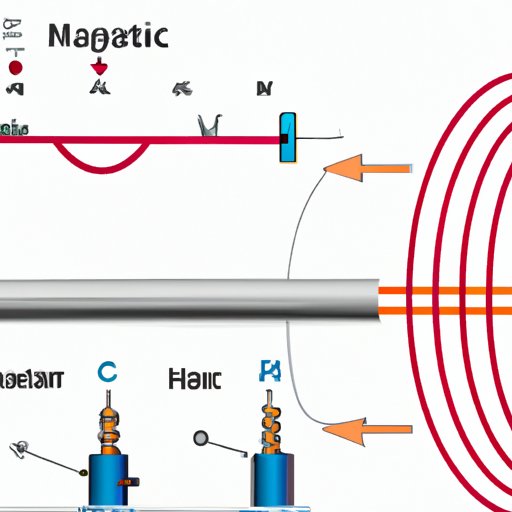Introduction
Electromagnetism is a branch of physics that studies the relationship between electricity, magnetism, and light. It is the basis for many of the electrical devices we use in our everyday lives, from generators and motors to electronics and communication. This article will explore the fundamentals of electromagnetism and examine how it works in everyday life.

Exploring the Basics of Electromagnetism
Before delving into the physics behind electromagnetism, it is important to understand some of the basic concepts. Charges and currents are two of the most important elements in electromagnetism. Electric charges can be either positive or negative, and when these charges move, they create an electric current. The movement of electric charges creates an electric field, which is a region of space where a force is exerted on other electric charge particles.
In addition to electric fields, magnetic fields are also created when electric charges move. Magnetic fields are regions of space that exert a force on magnetic materials and moving electric charges. The direction of the magnetic field is determined by the direction of the electric current.

Examining the Physics Behind Electromagnetism
The physics behind electromagnetism is based on two key laws: Faraday’s Law and Lenz’s Law. Faraday’s Law states that a changing magnetic field will induce an electric current in a closed circuit. In other words, if a wire is placed in a changing magnetic field, it will produce an electric current. This law explains how electric generators work.
Lenz’s Law states that an induced current will always flow in such a direction as to oppose the change in the magnetic field. This means that if a changing magnetic field is applied to a wire, the induced current will oppose the change in the magnetic field. This law explains how electric motors work.
Understanding the Role of Magnets in Electromagnetism
Magnets play an important role in electromagnetism. There are two types of magnets: permanent magnets and electromagnets. Permanent magnets are made of materials that have a naturally occurring magnetic field, such as iron or nickel. Electromagnets are made of coils of wire that are wound around a core of iron or another magnetic material. When an electric current is applied to the coil, it creates a magnetic field.
The interaction between magnetic fields is also important in electromagnetism. Magnetic fields exert forces on each other, and the strength of the force depends on the strength of the magnetic fields and the distance between them. This interaction explains why magnets can attract or repel each other.
Investigating the Interaction Between Electric and Magnetic Fields
The interaction between electric and magnetic fields is at the heart of electromagnetism. When a charged particle moves through a magnetic field, it experiences a force. This force is known as the Lorentz force, and it is what causes electric motors to turn. In addition, a moving charge also produces its own magnetic field, which interacts with the magnetic field it is moving through.
When a magnetic field changes, it induces an electric field. This induced electric field opposes the change in the magnetic field, according to Lenz’s Law. This phenomenon is known as electromagnetic induction, and it is the basis for electric generators.
Analyzing the Theory of Electromagnetic Induction
Faraday’s Law of Induction states that a changing magnetic field will induce an electric current in a closed circuit. This law explains how electric generators work. Lenz’s Law of Induction states that an induced current will always flow in such a direction as to oppose the change in the magnetic field. This law explains how electric motors work.
The theory of electromagnetic induction is based on the fact that a changing magnetic field induces an electric field, and this electric field then induces a current in a closed circuit. This phenomenon is at the heart of many of the electrical devices we use in our everyday lives.

Demonstrating How Electromagnetism is Used in Everyday Life
Electromagnetism is used in a wide variety of everyday applications. Generators and motors are two of the most common uses of electromagnetism. Generators use Faraday’s Law of Induction to convert mechanical energy into electrical energy. Motors use Lenz’s Law of Induction to convert electrical energy into mechanical energy.
The principles of electromagnetism are also used in electronics and communication. Electronics use electric currents to control the flow of electrons in circuits, while communication systems use electromagnetic waves to transmit information over long distances.
Conclusion
This article has explored the basics of electromagnetism, from charges and currents to Faraday’s Law and Lenz’s Law. It has examined how electromagnetism is used in everyday life, from generators and motors to electronics and communication. Electromagnetic principles are essential for understanding the world around us and the technology we use every day.
(Note: Is this article not meeting your expectations? Do you have knowledge or insights to share? Unlock new opportunities and expand your reach by joining our authors team. Click Registration to join us and share your expertise with our readers.)
